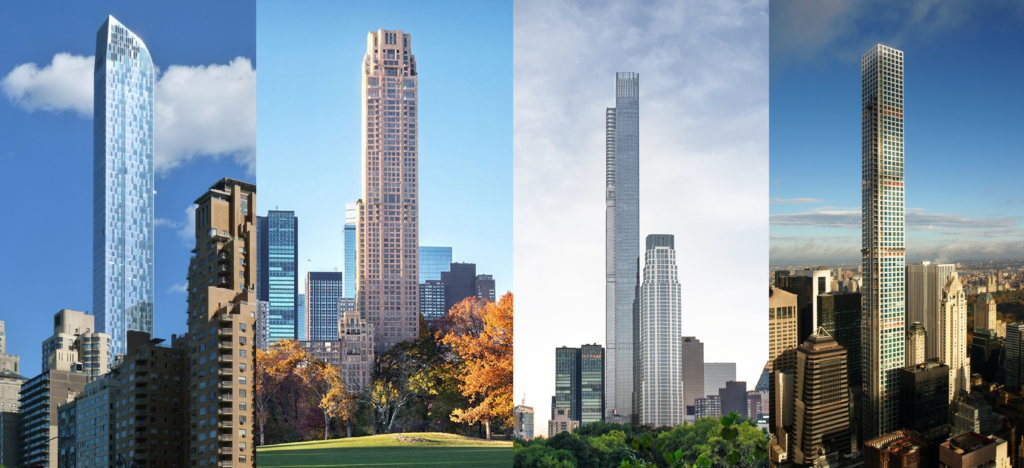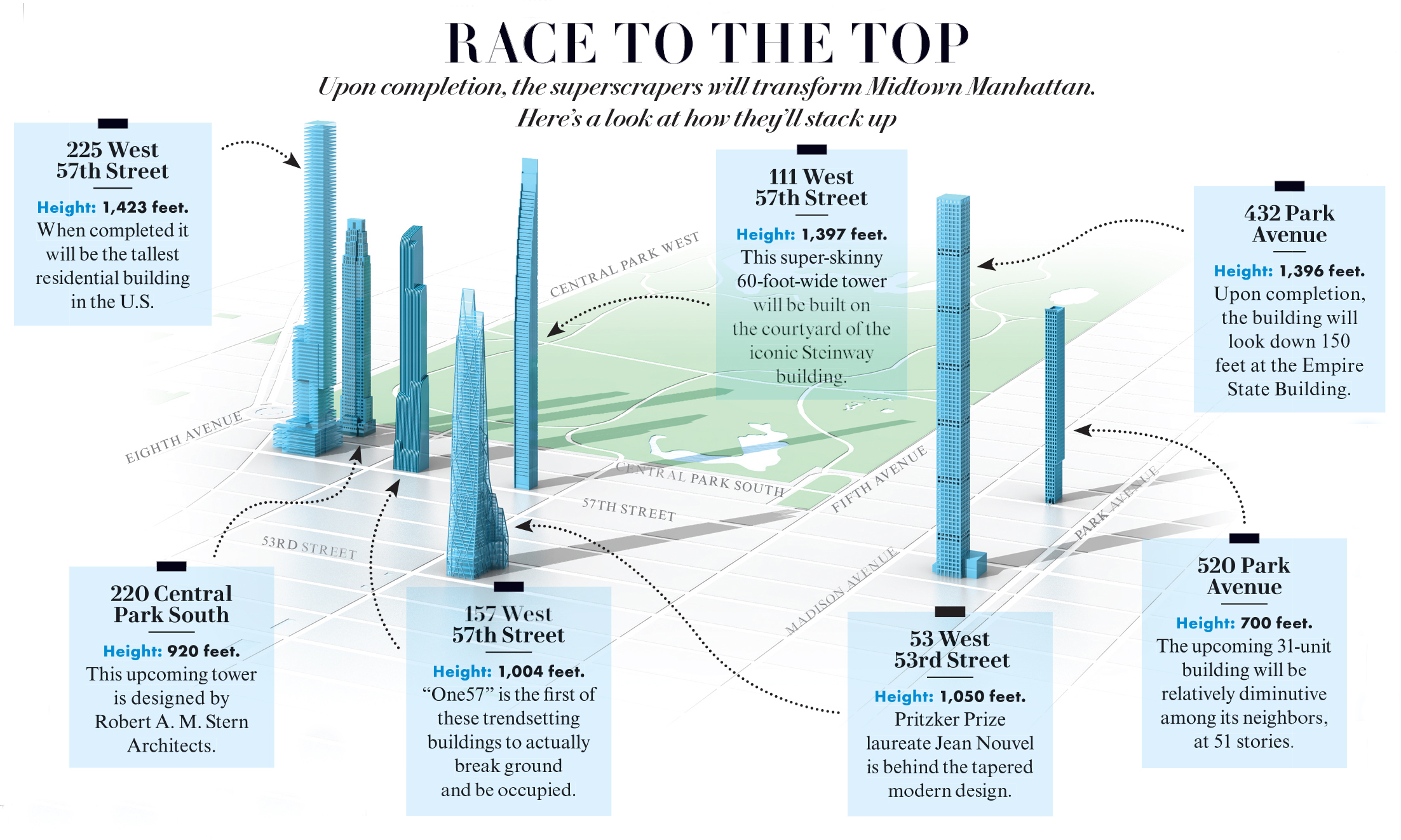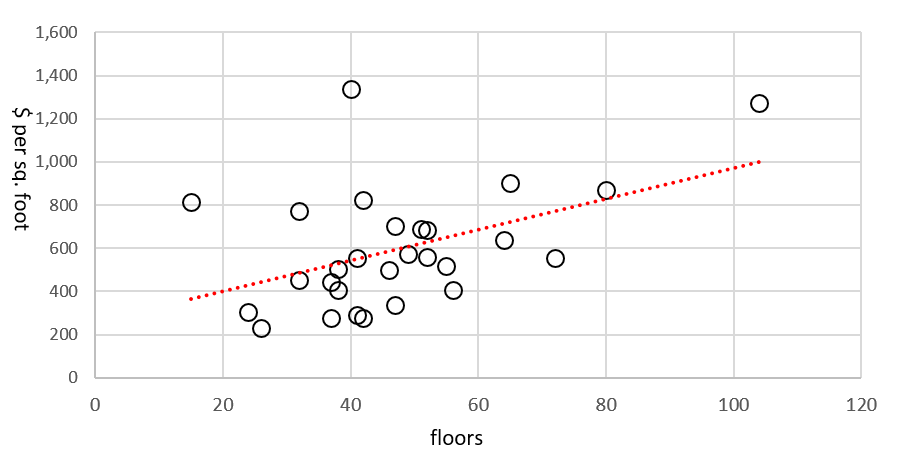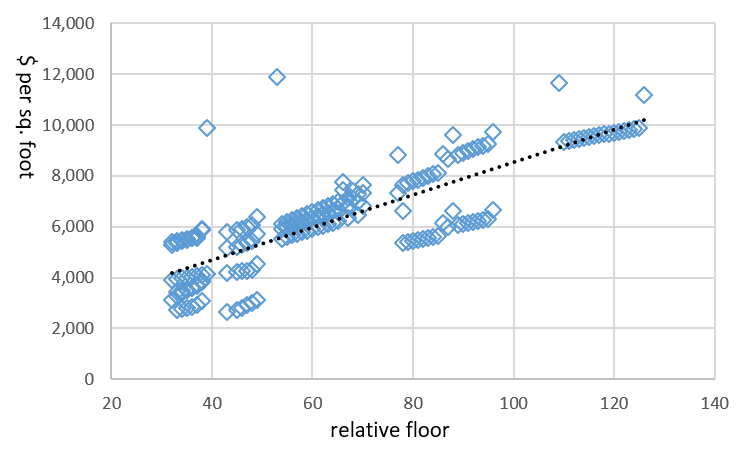By Jason M. Barr November 26, 2017
The Manhattan skyline was created by developers seeking their fortunes. Skyscraper heights, frequencies, types, and locations are based on the profits they generate. In the first half of the 20th century, for example, office buildings, such as the Woolworth (1913; 792 feet/241 meters) and Empire State (1931; 1250 feet/381 meters) reigned supreme.
Today, the princes of height are the superslim luxury residential towers, such as 432 Park Avenue (2015; 1396 feet/426 meters); 225 West 57th Street/Central Park Tower (under construction; 1550 feet/474 meters); and 111 West 57th Street/Steinway Tower (under construction; 1428 feet/535 meters).

In an earlier post, I discuss the reasons for their rise. Structural and engineering innovations, and a high demand from wealthy buyers, have created this new market. The relatively generous zoning regulations in central and lower Manhattan (and downtown Brooklyn) make this building type possible there and virtually impossible elsewhere.
Playing Developer
These towers, like all supertalls before them, are controversial (and which will be the subject of a future post). To understand a bit more about them, however, it might be of interest to play developer, and estimate the profits to constructing one. To do this I have created plans for a hypothetical 80-story superslim condo—the Barr Tower—on 57th Street. I have used three buildings, 432 Park Avenue, One57, and 220 Central Park South, as models.
For the interested reader, I have put together a document with my calculations and sources. My analysis is based on publicly available information (and a conversation with an industry professional). I believe it is reasonable from the data I have collected, but, not being a real estate insider, my analysis remains speculative, as it were.
Even a cursory investigation of Manhattan’s real estate market will show that there really is no typical or average project. Development is incredibly complex and includes a series of detailed and arcane steps; from the long drawn-out process of acquiring lots and air rights; to navigating the byzantine zoning and building codes; to amassing financing, and so on. It’s a game only for the hardy.
Having said that, if we want to understand the rise of the superslims, as a particular type, we need to make some simplifications. Here are my assumptions. First, the building is constructed under the current zoning regulations, and does not need any special permits from the city. That is, it is built “as of right.” Second, all the condo units have been sold by the time the building opens (this is the best case scenario).
Third, the building is fully residential, with no retail, offices, hotel, or parking. The assumption of a “pure” condo is a bit unrealistic, as most projects have some additional usages, but it complicates the analysis, and likely does not alter the conclusions by very much. Next, I use current market prices that seem typical for this high-end market as of mid-2017. Finally, I assume the building takes five years from initiating land purchases to the day the last condo contract is signed.
How to Build a Manhattan Superslim Skyscraper
Step 1: Acquire the land. The value of prime lots for development, along or near “Billionaires Row,” tends to fetch around $1,500 per square foot of allowable buildable space (which is set by the zoning rules), and which translates to about $18,000 per square foot of lot. I assume a relatively large lot of 30,000 square feet (2,787 meters). Cost of land: $540 million.
Step 2: Buy the air rights. In New York City, owners of lots that are less dense than the law allows can sell their unused floor area to a developer with an adjacent lot, who can then build taller as a result. Superslims would not be possible without the air rights market, as they allow developers to add more height than the zoning codes would otherwise permit. They usually sell at about half the cost of land per square foot. Cost of air rights: $97.5 million.
Step 3: Pay the soft costs: We need to hire an architect (better if it’s a “starchitect”), consult with engineers, hire a contractor, file plans, secure financing (and start paying interest), pay real estate taxes, etc., etc. In short, we must pay a series of expenses not directly related the construction of the structure itself. Soft costs: $264.1 million.
Step 4: Build the Structure. We need to hire a major General Contractor, who will deliver the building for a fixed cost plus management fee. Cost of structure: $700 million.
Step 5: Pose for pictures while cutting a ribbon. Total cost to build a superslim: $1.60 billion.
Now that we have our skyscraper, we cross our fingers and hope it will pay. With any luck, we will get back our investment and then some. To seek out an expected revenue stream, I have consulted offering plans submitted to the New York State Attorney General.
These legal documents spell out the details of the building and the expected market price for each unit. Table 1 gives four examples. The average across these four buildings is $6,800 per square foot. But recently prices have dropped somewhat given a surge in luxury units coming onto the market. Based on my conversations with an industry insider, I assume a conservative average of $6,000 per square foot, minus 6% for marketing and closing costs. Total Revenue: $2.76 billion.
| Address | Year Completed | Floors | Projected Revenue from Condos ($billion) | Avg. Projected Condo Price per ft2/m2 |
| One57 | 2014 | 75 | 2.0 | $4,878 /$52,506 |
| 432 Park Avenue | 2015 | 85 | 2.9 | $6,894 / $74,206 |
| 220 Central Park South | 2018 (est.) | 66 | 3.4 | $8,318 / $89,535 |
| Central Park Tower | 2020 (est.) | 95 | 4.0 | $7,106 / $76,488 |
Return on Investment
In short, for the cost of $1.60 billion, you can expect to get $2.76 billion back, for a profit of $1.16 billion, a total return on investment of 73%. But, also consider that it took five years from start to finish; an average annual return of 10.9%.
Truthfully, however, this understates the return to investors. Most projects are financed with both equity and loans. If we assume that about 30% of the project came from equity, then the return on this investment would be 130% over five years, or about a 16.6% average annual return.
Without collecting data on many such projects, there is no way to know the variation in returns. That so many supeslims are being built suggests that the first crop were profitable and that developers remain bullish. But an average annual return on investment of 10.9% does not strike me as particularly high, given the risks. My estimates of the growth in land values, for example, in Manhattan in the last decade has been close to 16%. In the last five years, the average annual growth rate in the Dow Jones Industrial average has also been around 11%.
New York City is a great city because of its skyscrapers. But it does suffer from a housing affordability problem for lower income residents. In future posts, I will investigate the return on investment for housing outside the city center and what might be done to alleviate the crisis.




